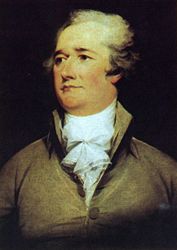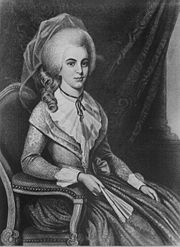The Real Alexander Hamilton
You know Hamilton as the face on the $10 bill. And if you remember your high school history, you know he was one of the Founding Fathers; a contemporary of Washington, Jefferson, and Madison. But do you know how important he was to the nation, and why?
War Hero
For starters, Hamilton was a bona fide war hero. In 1775, while a student at King's College (now Columbia University), he joined a volunteer militia company and led a successful raid on a British position in the Battery (now a park in lower Manhattan). He subsequently raised an artillery company of 60 men, was elected captain, and caught the attention of General Washington by his proficiency and bravery at the Battle of Harlem Heights and the Battle of Trenton. He became Washington's aide-de-camp in March 1777 with the grade of lieutenant colonel and served in that position for four years, handling a variety of high-level duties including (due to his fluent French) liaison with Lafayette and other French commanders.
Although he wielded significant influence as Washington's chief of staff, Hamilton repeatedly sought a combat command position. He got his wish in July 1781. In command of three infantry battalions at the Battle of Yorktown (Sep-Oct 1781), Hamilton fought bravely, capturing Redoubt #10 of the British fortifications (the French took #9), which led to Cornwallis's surrender.
Continental Congress and the Constitutional Convention
Hamilton resigned his military commission after Yorktown, and in 1782 was elected to the Continental Congress, representing New York. Following the Newburgh Conspiracy, he left the Congress and opened a law practice in New York City. In 1784 he founded the Bank of New York, now the oldest continuously operating bank in the US and the first corporate stock to be traded on the New York Stock Exchange (1792).
He served in the New York State Legislature in 1787 and was the first delegate chosen for the Philadelphia Convention of 1787, which has come to be known as the Constitutional Convention. Although the ostensible purpose of the convention was to revise the Articles of Confederation to remedy certain perceived defects, chiefly related to trade, Hamiliton, Madison, and other proponents of a strong central government saw it as an opportunity to scrap the Articles of Confederation altogether and create a new national government.
At the convention, Hamilton's own proposal was rejected as too similar to the British system. Several states offered competing plans, and after much compromise the delegates settled on a draft Constitution. Hamilton was not alone in expressing reservations about the document,1 but he took the lead defending it in New York after opponents published articles and letters arguing against it.
He convinced Madison and John Jay (a prominent New York lawyer and later chief justice of the US) to collaborate on a series of essays advocating the Constitution's ratification. These 85 essays—most of which were written by Hamilton2—are now known as the Federalist Papers. Although they are given some credit in achieving ratification,3 their chief value lies in being the major contemporaneous interpretation of the Constitution. To this day, they are cited by judges, lawyers, historians, and political scientists more than any other primary source on the subject.
Secretary of the Treasury, 1789-1795
Hamilton's impact as the first secretary of the treasury was profound. Through a series of formal reports to Congress (a practice he established as a means of creating and implementing new programs) and other actions, he strengthened the power of the federal government over state governments and firmly established an expansive view of the authority granted under the Constitution. Within his term he put in place a modern financial system, replacing the chaotic one of the confederacy; this gave the government financial stability and gave investors the confidence needed to support government bonds.
- He had the federal government assume states' debts incurred during the Revolution. This highly controversial proposal, originally opposed by Jefferson and Madison, established the credit worthiness of the US, ushered in an era of wide prosperity, and made possible the Louisiana Purchase.
- He formulated a liberal construction of the General Welfare clause and laid out a broad vision of a dynamic industrial economy, countering Jefferson's vision of an agrarian nation of farmers and encouraging the growth and protection of manufacturing. (Jefferson later came to embrace Hamilton's vision.)
- He help found the first national bank (the Bank of the United States), the forerunner to the Federal Reserve System. Opposed (again) by Jefferson on the basis that the Constitution did not expressly authorize it, Hamilton succeeded in arguing that the Necessary and Proper clause gave elasticity to the Constitution and "implied" powers to the federal government. Jefferson himself later invoked this Constitutional doctrine to justify the Louisana Purchase, and it was enshrined by the Supreme Court in the seminal case of McCulloch v. Maryland.
- He was instrumental in establishing and expanding a system of tariffs, duties, and excise taxes as a means of funding the national government. (Income taxes were not established until 1861, and they were considered unconstitutional from 1895 until 1913, when the 16th Amendment was ratified.)
- He help found the US Mint.
- He established the US Revenue Cutter Service, an armed maritime law enforcement service that merged with the Lifesaving Service in 1915 to form the US Coast Guard. As late as 1962 (during the Cuban Missile Crisis), the US Navy was still using ship-to-ship communication protocols written by Hamilton.
Later Life, 1795-1804
Hamilton resigned as Secretary of the Treasury in early 1795 in the midst of a sex scandal. (Some things never change!) He returned to his law practice but remained active in politics, continuing to advise Washington and other cabinet members and influencing the presidential elections of 1796 and 1800, though not without controversy. In 1798, during the Quasi-War with France, President John Adams appointed Hamilton a major general, making him the de facto head of the US army. Hamilton organized an army and made plans to defend the nation (and seize Spanish possessions in Louisiana and Mexico), but negotiations with France averted hostilities.
Hamilton effectively founded the Federalist party, the nation's first political party, in the mid-1790's and led it until about 1800. But a pamphlet he wrote in 1800 critical of John Adams split the party and ended Hamilton's dominance.
In the New York gubernatorial election of 1804, Hamilton helped Morgan Lewis, a Jeffersonian, defeat Aaron Burr, then the vice president. There had long been bad blood between Hamilton and Burr, and when a newspaper published an account of an insult allegedly made by Hamilton, Burr challenged him to a duel—the most infamous in American history.
----------------------------------
1Probably none of the 39 men who signed the Constitution was fully satisfied with it. Benjamim Franklin, in defense of the final draft said, "[T]here are several parts of this Constitution which I do not at present approve, but I am not sure I shall never approve them: For having lived long, I have experienced many instances of being obliged by better information, or fuller consideration, to change opinions even on important subjects . . . . I doubt too whether any other Convention [could] make a better Constitution. . . . It therefore astonishes me, Sir, to find this system approaching so near to perfection as it does . . . . I can not help expressing a wish that every member of the Convention who may still have objections to it, would with me, on this occasion doubt a little of his own infallibility, and to make manifest our unanimity, put his name to this instrument."2There is some dispute as to the authorship of 12 of the essays, but by any count Hamilton was responsible for at least 51 (3 co-authored with Madison).
3The essays were primarily intended to sway public opinion in New York State. The first 77 were published in New York newspapers from October 1787 to August 1788, and although Hamilton encouraged their publication in other states, his success in accomplishing that was irregular at best. By the time New York ratified the Constitution (26 July 1788), 10 other states had already done so; only 9 were needed for it to take effect.
![]()


